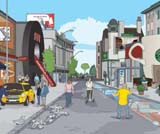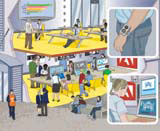Design to turn 2015 Creative World sci-fi into a reality

Give it just ten years and things could be looking very different in the UK. What was once the stuff of sci-fi is slowly creeping into our home, workplace and high street, such as branded schools, homes pasted with LED screens and ovens storing digital recipes – all this could be the norm come 2015.
Creative World, co-written by Richard Benson, former editor of The Face, David Rainbird, co-founder of design consultancy Fibre, and Ekow Eshun, creative director of the Institute of Contemporary Arts, outlines a blueprint for the future by examining current trends in branding, media and technology.
The idea for the book came from Chancellor Gordon Brown’s Budget speech, where he referred to the booming creative economy, which is currently growing by 8 per cent each year. Illustrations by Ben Hasler show what our schools, homes, offices, bars, restaurants, cafés and clubs could potentially look like, and the vision is not far from the reality that is currently being realised by UK designers.
For example, the book depicts a man pointing his phone at a bus stop in order to download local transport information. Innes Ferguson, head of design at Transport for London, has already spoken to Design Week exclusively about his plans to design interactive systems like these for bus shelters (DW 15 September).
In the bars of the future, we could be drinking from ‘intelligent glassware’ that records alcohol consumption. Smart Studio, a research group within the Interactive Institute, Stockholm, has already built a prototype, displayed at Touching the Invisible, a Onedotzero exhibition this summer (DW 2 June).
Retail outlets will be designed as destination stores that blend shopping with conceptual art. This format is currently being trialled by Timberland for its sub-brand flagship store, Timberland Boot Company. Checkland Kindleysides has designed the interiors (DW 8 September).
A move towards ambient marketing may result in a proliferation of subliminal messaging, whereby a company will rely more on customer familiarity to sell its product and less on an iconic brand representation. This could potentially erase the need for a logo altogether. The seeds of this trend can already be seen in the tobacco industry, for which Fitch has reportedly carried out various ‘sensory branding’ projects, working for British American Tobacco (DW 30 June).

Schools could be transformed into co-branded institutions, such as an Apple Computer academy, for example, and children could be educated via wireless devices.
Lin Dickens, managing director at Aricot Vert, says, ‘Potentially, this could be very exciting, but it can’t be superficial and must be done in a truly altruistic way and not be about cynical branding.’ Aricot Vert has undertaken various branding projects for Ruislip High School, Stockley Academy and Harefield.
‘In ten years’ time, we may still live in the same houses, but our behaviour could have changed to affect our cultural development. Designers are shaping our future and where there is creative injection, there will be opportunities for designers,’ says Rainbird, who has been instrumental in creating the book.
Rainbird speculates that, as a discipline, design may change as consumers start creating their own products.
‘There is a creeping trend for customisation – borders between consumers and designers are becoming more fuzzy. The designer is not endangered, but there is a broadening of creative potential,’ he adds.
The design sector could be on the brink of its most exciting evolutionary phase yet.
Life in 2015
• Labels on products augmented by embedded chips, which can be scanned to trigger an interactive response
• Internet café boom with coffee shops providing pods, rentable by the hour, where people can catch up on e-mails
• Public spaces becoming prime advertising locations
• Further integration of technology across lifestyle activity, such as the development of a Web-linked kitchen
• Churches transformed into multi-faith meeting centres
• Hard currency replaced by a flexible bartering system, where individuals trade their time and services
-
Post a comment



